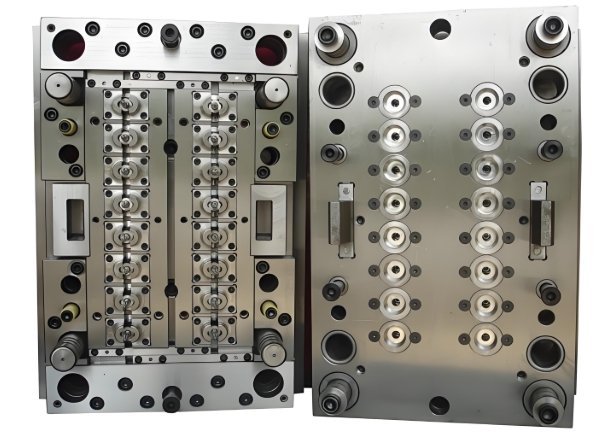
Nanotechnology is revolutionizing medical injection molding. It improves material strength, precision, and biocompatibility. Mold makers are using nano-enhanced plastics to create safer and more durable medical devices. This technology is driving innovation in implants, drug delivery systems, and surgical tools.
What is Nanotechnology in Medical Injection Molding?
1. Definition
Nanotechnology involves manipulating materials at the molecular level. It enhances the properties of plastics used in medical injection molding.
2. Why It’s Important
- Improves mechanical strength.
- Enhances biocompatibility for medical use.
- Reduces contamination risks.
- Enables micro-molding for tiny medical components.
Key Benefits of Nanotechnology in Medical Injection Molding
1. Increased Material Strength
- Nano-fillers reinforce polymers, making them more durable.
- Stronger materials reduce breakage in medical devices.
2. Enhanced Biocompatibility
- Nanocoatings prevent adverse reactions in the human body.
- Ideal for implants and surgical instruments.
3. Improved Sterility
- Nano-antimicrobial additives kill bacteria on contact.
- Enhances the safety of medical injection-molded products.
4. Better Thermal and Chemical Resistance
- Nano-enhanced plastics withstand high temperatures.
- Ensures stability during sterilization processes.
5. Ultra-Precise Micro-Molding
- Nanotechnology allows for ultra-small medical parts.
- Used in microfluidic devices, drug delivery systems, and nano-implants.
Nanotechnology-Enhanced Materials in Medical Injection Molding
1. Nano-Filled Polymers
- Improves mechanical properties without increasing weight.
- Used in high-strength surgical tools and medical casings.
2. Nanocomposites for Medical Implants
- Increases durability and biocompatibility.
- Reduces rejection risks in the human body.
3. Antimicrobial Nanocoatings
- Silver and copper nanoparticles prevent bacterial growth.
- Enhances safety for catheters, syringes, and wound dressings.
4. Conductive Nanomaterials
- Used in smart medical devices and biosensors.
- Enables real-time patient monitoring.
5. Self-Healing Nanopolymers
- Repairs minor cracks and damage in medical devices.
- Extends the lifespan of molded components.
How Nanotechnology is Improving Medical Injection Molding Processes
1. Enhancing Mold Surface Properties
- Nano-textured molds create smoother, more precise components.
- Reduces friction and material defects.
2. Reducing Material Waste
- Nano-fillers allow for thinner, stronger medical parts.
- Lowers raw material usage in manufacturing.
3. Faster Cooling and Cycle Times
- Nano-enhanced materials improve heat dissipation.
- Reduces production time and increases efficiency.
4. Improving Adhesion in Overmolding
- Nanotechnology enhances bonding between multiple materials.
- Ideal for soft-touch medical devices.
5. Enabling Smarter Injection Molding
- Nanomaterials enhance sensor integration in medical devices.
- Improves real-time monitoring of patient health.
The Role of Mold Makers in Nanotechnology Integration
1. Designing Molds for Nano-Precision
- Mold makers create ultra-smooth, high-precision molds.
- Ensures defect-free nano-enhanced medical components.
2. Selecting Nano-Enhanced Polymers
- Works with manufacturers to choose biocompatible nanomaterials.
- Ensures compliance with medical industry regulations.
3. Adapting Molding Techniques for Nano-Materials
- Adjusts pressure, temperature, and cooling times.
- Optimizes mold flow for nano-filled plastics.
4. Maintaining Mold Longevity
- Nanocoatings prevent wear and tear on molds.
- Increases durability and reduces maintenance costs.
Challenges of Using Nanotechnology in Medical Injection Molding
1. High Material Costs
- Nano-enhanced plastics are more expensive.
- Costs may decrease with wider adoption.
2. Regulatory Approval Complexities
- FDA and ISO require extensive testing for nanomaterials.
- Compliance takes time and resources.
3. Need for Specialized Equipment
- Nano-molding requires advanced precision machinery.
- Upgrading production lines can be costly.
4. Safety Concerns in Nanomaterial Handling
- Some nanoparticles pose health risks.
- Strict safety protocols are required for production.
Latest Innovations in Nanotechnology for Medical Injection Molding
1. 3D Nano-Printing for Mold Prototyping
- Creates highly detailed mold prototypes.
- Reduces development time and costs.
2. Graphene-Enhanced Medical Plastics
- Improves strength, conductivity, and biocompatibility.
- Used in advanced drug delivery systems.
3. Smart Nanocoatings for Self-Sterilizing Devices
- Uses UV-activated nanoparticles to kill bacteria.
- Ideal for reusable medical instruments.
4. AI-Optimized Nano-Molding Processes
- AI fine-tunes nano-molding parameters in real time.
- Reduces defects and improves efficiency.
5. Nano-Embedded Biosensors in Medical Devices
- Enables real-time tracking of patient health.
- Used in smart insulin pumps and implantable sensors.
Future Trends in Nanotechnology for Medical Injection Molding
1. Fully Biodegradable Nano-Enhanced Medical Plastics
- Reduces environmental impact of disposable medical devices.
- Maintains strength and sterility.
2. AI-Driven Nanotechnology Development
- AI will accelerate the creation of new nano-polymers.
- Enhances material properties for medical applications.
3. Nano-Engineered Personalized Medical Devices
- Tailored implants and prosthetics based on patient genetics.
- Custom drug-delivery systems for targeted treatments.
4. Ultra-Lightweight and Strong Nano-Materials
- Stronger than traditional plastics yet ultra-light.
- Improves wearability and comfort for medical devices.
5. Integration of Quantum Dots in Medical Molding
- Enhances imaging capabilities in medical diagnostics.
- Used in nano-scale biosensors for early disease detection.
Nanotechnology is transforming medical injection molding. Mold makers are using nano-enhanced materials to create stronger, safer, and more precise medical devices. As technology advances, nanotechnology will continue to drive innovation, improving patient safety, manufacturing efficiency, and sustainability.
